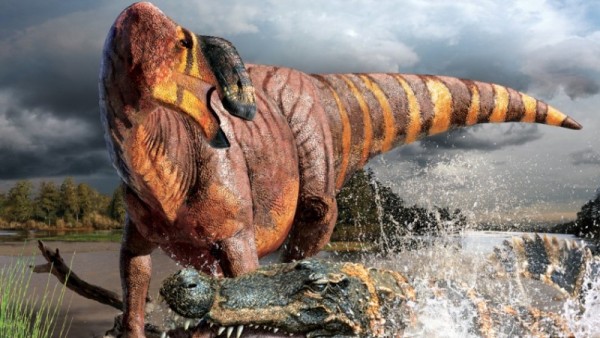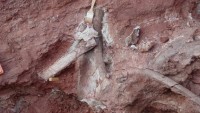Dinosaur with a Huge Nose Discovered in Utah
| Des Cambaliza | | Sep 20, 2014 06:45 AM EDT |
(Photo : Terry Gates) The newly discovered hadrosaur, Rhinorex condrupus, has a truly distinctive nose.
Paleontologists have discovered a new dinosaur, a hadrosaur with a huge nose, according to a recent study by North Carolina State University.
The dinosaur is named "Rhinorex condrupus," where "Rhinorex" roughly translates into "King Nose," was believed to have roamed Utah about 75 million years ago.
Like Us on Facebook
Postdoctoral researcher Terry Gates of NC State University and NC Museum of Natural Sciences and Brigham Young Museum of Paleontology's Rodney Sheetz found the fossil in a BYU storage site.
The almost complete skull allowed them to reconstruct the huge nose, which led them to realize they had discovered a new species.
The Rhinorex, a plant eater, was estimated to have a length of 30 feet and a weight of 8,500 lbs. It lived in a swampy estuary 50 miles (80 kilometers) from coast during the late Cretaceous period, according to the study.
It's an addition to the hadrosaurs family tree, which included Edmontosaurus and Parasaurolophus of the same time period.
Cretaceous hadrosaurs are distinguished by their bony crests connected to the skull. But the top of Rhinorex's head has no crest, only a prominent nasal profile.
Gates and her colleague have yet to find out if its large nose had any special purpose. But based on what's known about other hadrosaurs' sense of smell, Rhinorex probably didn't have an extreme olfactory sense.
Gates suggested the nose could be a means to attract mates or a way to smash plants for food.
The fossil was first unearthed from the Neslen site in Utah in the 1990s. But it was only recently researchers reconstructed the bones. The job took them two years, Gates said.
This Rhinorex was the only complete hadrosaur fossil they excavated from Neslen. Other Cretaceous hadrosaurs, which were incomplete, were found 200 miles (322 kilometers) south.
The new discovery gave researchers to more information about the period's geography, particularly habitat segregation, the study said.
TagsScience, Paleontology, North Carolina State University, Terry Gates, Rodney Sheetz, Brigham Young Museum of Paleontology, Rhinorex, hadrosaur, Fossil
©2015 Chinatopix All rights reserved. Do not reproduce without permission
EDITOR'S PICKS
-

Did the Trump administration just announce plans for a trade war with ‘hostile’ China and Russia?
-

US Senate passes Taiwan travel bill slammed by China
-

As Yan Sihong’s family grieves, here are other Chinese students who went missing abroad. Some have never been found
-

Beijing blasts Western critics who ‘smear China’ with the term sharp power
-

China Envoy Seeks to Defuse Tensions With U.S. as a Trade War Brews
-

Singapore's Deputy PM Provides Bitcoin Vote of Confidence Amid China's Blanket Bans
-

China warns investors over risks in overseas virtual currency trading
-

Chinese government most trustworthy: survey
-

Kashima Antlers On Course For Back-To-Back Titles
MOST POPULAR
LATEST NEWS
Zhou Yongkang: China's Former Security Chief Sentenced to Life in Prison

China's former Chief of the Ministry of Public Security, Zhou Yongkang, has been given a life sentence after he was found guilty of abusing his office, bribery and deliberately ... Full Article
TRENDING STORY

China Pork Prices Expected to Stabilize As The Supplies Recover

Elephone P9000 Smartphone is now on Sale on Amazon India

There's a Big Chance Cliffhangers Won't Still Be Resolved When Grey's Anatomy Season 13 Returns

Supreme Court Ruled on Samsung vs Apple Dispute for Patent Infringement

Microsoft Surface Pro 5 Rumors and Release Date: What is the Latest?













